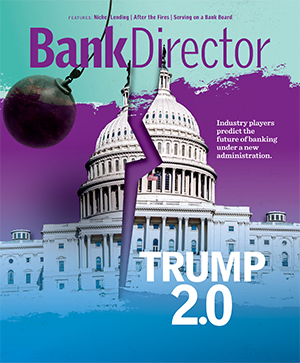Alan J. Kaplan is the Founder and CEO of Kaplan Partners, a 31-year-old Philadelphia-based retained executive search and board advisory firm. You can reach Alan at 610-642-5644 or [email protected].

Plan for Unplanned CEO Transitions
Having a well-developed, up-to-date emergency succession plan is a vital part of due diligence for banks.
Brought to you by Kaplan Partners

Since the founding of our firm over 30 years ago, we’ve been fortunate to assist clients with more than 100 president or CEO succession projects across the financial services landscape. When reviewing these successful assignments with an eye towards common themes, I was struck by the number of leadership transitions that occurred unexpectedly. While the frequency of unplanned changes at the top of the house truly surprised me, the causes of these unexpected changes varied widely, including:
- Surprise or early retirement.
- Resignation for personal or family reasons.
- Termination for poor performance.
- Termination for inappropriate behavior.
- Being nudged out by the board after staying too long without a plan.
- Death or serious illness.
One only needs to read the news in any major business publication to see that almost every day the CEO of a major public company, private equity-backed enterprise or financial institution exits for one reason or another. Unplanned transitions simply occur much more often than we’d like to think.
The vast majority of bank boards, whether public, private or mutual, are well aware of the need to have an emergency succession plan. Regulators require this, of course, and it is a best practice to regularly refresh this plan as time passes and conditions and options evolve. Even banks with new leaders — whether selected internally or externally —should review and revise the emergency plan shortly after a new leader arrives and annually thereafter.
For example, a new leader selected internally after a comparative evaluation process may have been the emergency choice, requiring the identification of a new backup plan. Or the “name in the envelope,” as it is often called, may retire or simply depart concurrent with a new leader’s arrival, forcing a fresh assessment of the talent pool of internal emergency successors.
Sometimes we observe that when a new leader is promoted from within the organization, the prior CEO remains on the board or as an “adviser” to the bank. In these situations, the recently retired CEO may be an excellent choice to step in during a time of unexpected upheaval. However, this plan only works if the need for the emergency fill-in occurs not long after the transition itself takes place — perhaps a few years at most. This plan also assumes that the interim replacement had a high level of continuing engagement at the board level. Otherwise, it could backfire due to a lack of currency with the bank, regulatory climate and broader industry dynamics.
The goal of an emergency succession plan is not necessarily to solve a longer-term CEO succession issue. Rather, it is to keep the train on the tracks and to reassure employees, customers and communities that the bank’s continuity is not tied to any one individual. This allows the board time to evaluate options, potentially recruit or elevate a new leader and to just breathe after this unexpected event.
Some directors, and even CEOs, think this cannot happen to their institution, whether because of the youth of their leader or the faith they have in the depth of the team. However, in my home state of Pennsylvania already this year, there have been three unexpected leadership transitions in the industry. Things happen, and the more prepared the board is to expect the unexpected, the more likely the bank is to maintain its momentum and continued independence.


